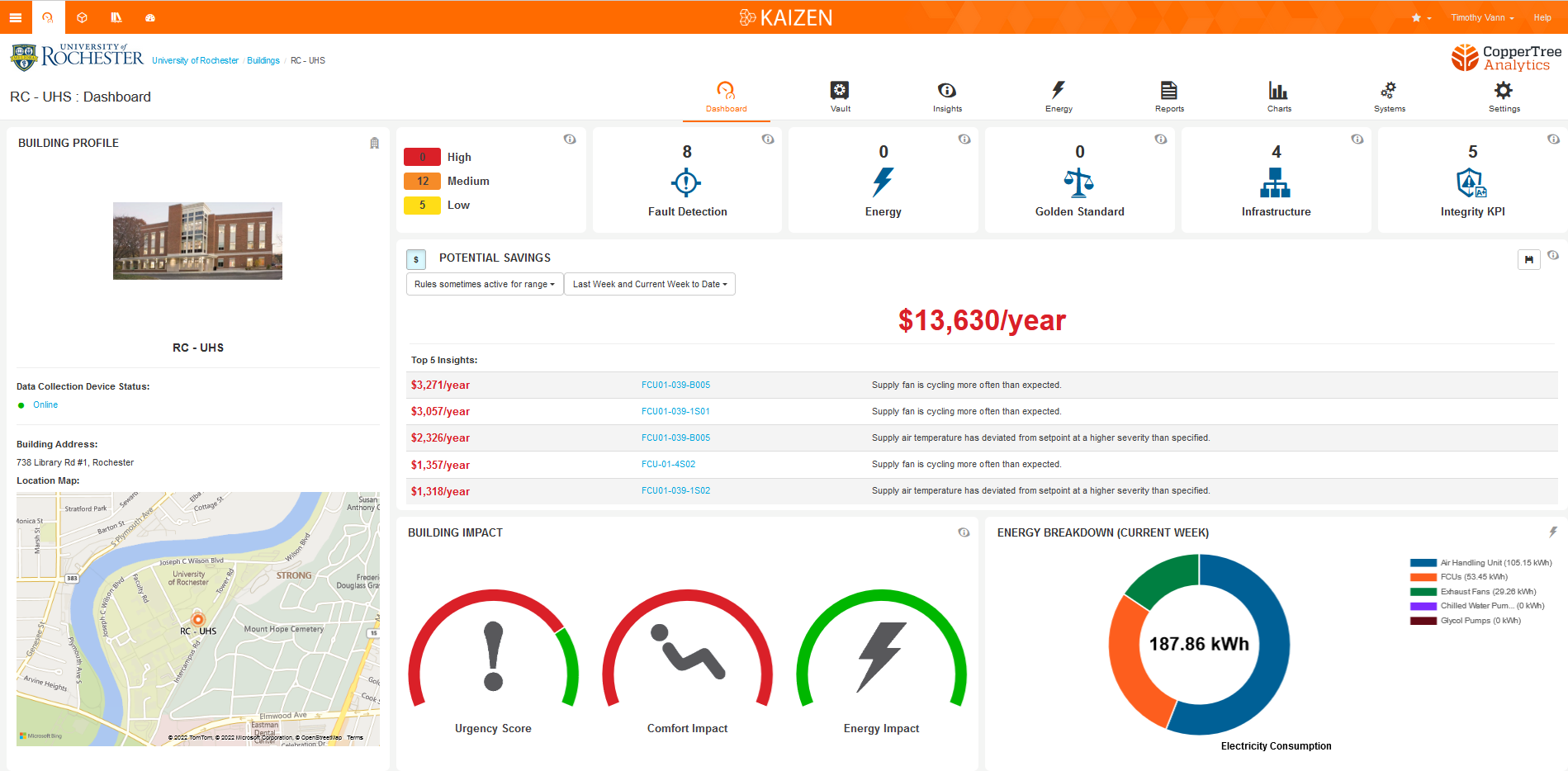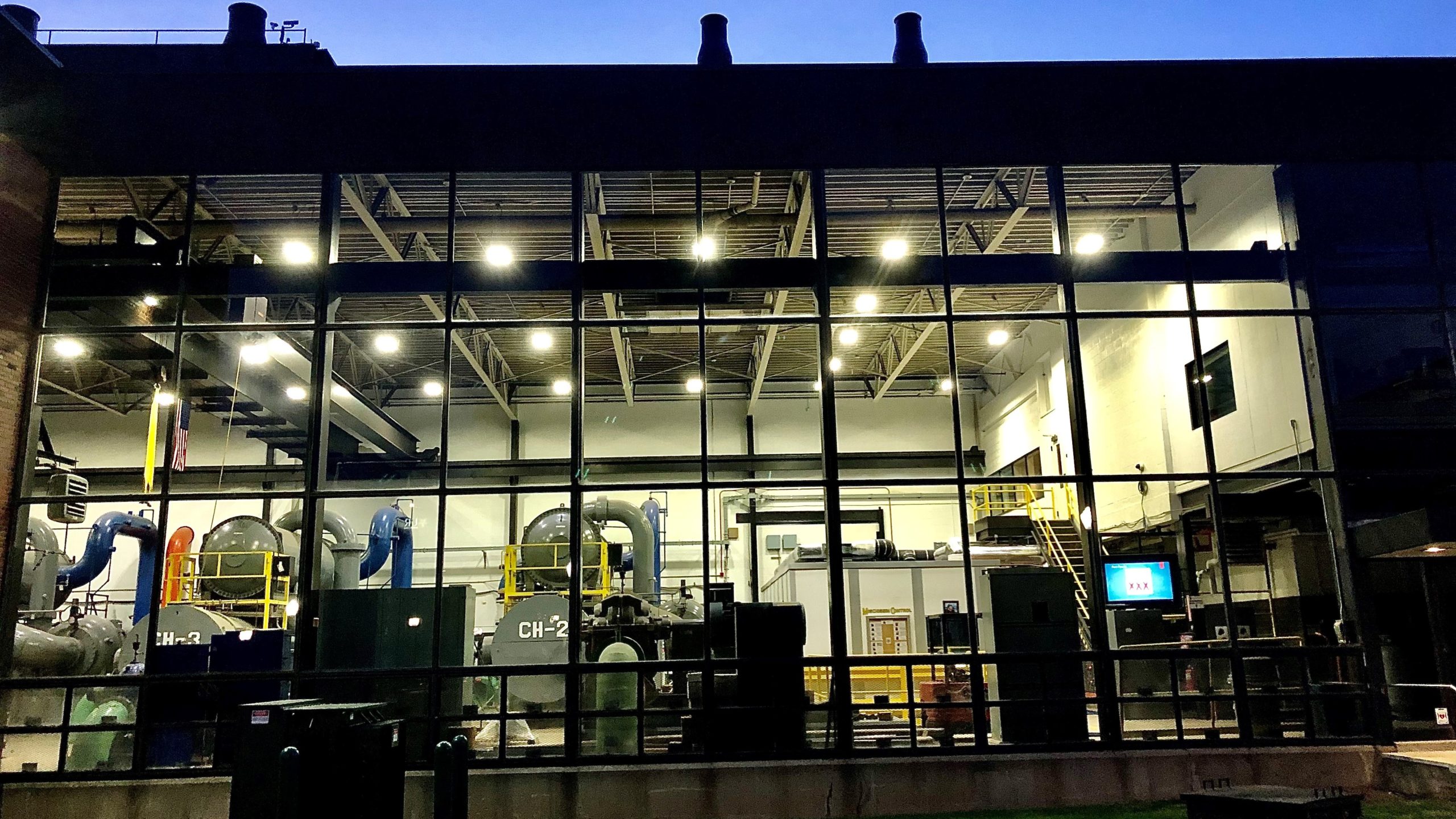Energy Services provided by Utilities and Energy Management (UEM) to serve River Campus and Medical Center buildings, produce about 85% of the University’s total carbon emissions. Fault detection and diagnostics (FDD) and building scheduling optimization (BSO) are two pilot programs running concurrently as UEM works to increase energy efficiency, save the University money, and decrease carbon emissions. Facilities Team Green sat down with Energy Engineer Tim Vann and Assistant Director of Building Controls and Energy Operations Rich Stein, at UEM to learn more about these projects, sponsored by Director Mike Whitmore.
FDD and BSO are both connected to the building automation system (BAS) which is a network of control systems throughout every building on campus. The University currently uses three different BAS systems: Schneider Electric EcoStruxure, Automated Logic WebCTRL, and Siemens Desigo. The controllers are placed throughout buildings on campus that have sensors which report data such as humidity levels, temperature, and fan control status. The controllers also command the equipment on how to run, such as starting or stopping a fan. If any piece of equipment stops working, the system sends out an alarm to customer service.
Fault detection and diagnostics
Rich Stein explained FDD stating, “What FDD does is it looks at the operating data for each building and makes longer term pattern recognition. So it looks at it as, ‘Hey, we noticed when your chilled water valve is closed, you’re getting additional cooling out of it when you’re not supposed to.’ It’s not creating an alarm condition, it’s just an opportunity to not waste some energy.”
Tim Vann added on, “FDD finds two categories of issues: things that are slightly broken and affecting the operation but not broken enough that it generates alarms in the main system and things that are not broken, but also not operating as efficiently as they should be.”
UEM is currently testing out two different FDD softwares, KGS Clockworks and Kaizen CopperTree Analytics, designed to identify areas of improvement in efficiency. Each software is connected to three different buildings, each of which is using a different BAS control system to test how well the software will work with the current University setup. KGS Clockworks is connected to LeChase Hall and Wegmans Hall on the River Campus and Helen Wood Hall at the Medical Center, two of which have been fully connected since May. Coppertree is still in the debugging phase and has only been used for about a week and a half as of June 16. It is connected to University Health Services (UHS) and Genesee Hall on the River Campus and the Saunders Research Building at the Medical Center.

Before they started using this software, UEM workers would stumble upon problems while they were working on a separate issue. The FDD software is connected to hundreds of devices in each building and is collecting data 24/7. The flagged problems, or areas of improvement, spotted by FDD are viewable on each software’s dashboard and can rank the issues in terms of cost, customer comfort, urgency, and energy.
The FDD pilot team has met with other schools, including Emory, Wake Forest, Yale, and MIT, about their experiences with FDD. They found that it has helped reduce energy consumption by up to 20% in some buildings at these schools.
The piloting of the two FDD softwares is expected to last around a year. Their goal is to rate each company’s software as well as their services and see how effective they are at finding issues, their cost effectiveness, and their ease of use. At the end of the pilot, UEM will analyze the data to see if they want to continue with FDD at all, and if so will they pick only one vendor, or use both.
Building Scheduling Optimization
UEM is also running a building scheduling optimization pilot, without the use of any new software. As Vann noted, “A lot of our buildings have been scheduled to run the HVAC systems a lot more than they need which waste energy.” BSO aims to reduce building temperature scheduling hours to only necessary ones and utilize building zones to concentrate energy usage to specific areas, rather than the whole building. The current buildings they are working on are Rush Rhees, Morey, Rettner, University Facilities Center, and Sloan. The first phase is expected to last around a year. The team plans to add a building every six weeks. UEM will start adding Medical Center buildings in the late summer or early fall of 2022.
The BSO team is also piloting an interface between the Event Management System (EMS) which manages classroom schedules and the Building Automation Systems (BAS) which controls the HVAC systems. This connection has the potential to optimize the heating and cooling of rooms to only the times the rooms are in use, thus, optimizing the energy used to condition the space. The hope is that when the EMS schedule is updated, so will the BAS, taking work off of the employees hands. This pilot is currently running at Sloan.
Most of the Medical Center buildings are scheduled around the clock but Vann anticipates finding some areas to reduce scheduling in the office areas and potentially some research spaces that do not require stable temperatures 24/7. UEM plans to reach out to people that manage departments in the Medical Center to learn more about their scheduling needs.
Vann brought up a study he’d read on theoretical testing of building energy conservation measures. The study ranked 43 tested measures on cost effectiveness and fixing schedules came out to be either the number one or number two best option in every scenario. Vann noted,
“Honestly, the building scheduling is something we should have already been doing. It’s good that we’re going through and trying to fix it now.”
Ties to sustainability
The goal for both FDD and BSO is to reduce energy consumption in University buildings. The majority of buildings are connected to the power plant, so the total energy consumed by the power plant will also decrease. Vann is on one of the working groups for the University’s sustainability plan and anticipates that these pilot programs will help reduce our carbon footprint. UEM has a goal to reduce energy consumption by at least 10% in the buildings they are testing these pilots in, with 15% expected to be the highest.
As the pilots progress, Vann and others at UEM will need to decide if they are worth doing on a larger scale. Vann noted they still have a lot of learning to do with the softwares and need to train others. In the end, he suspects they will be worth it, but only time will tell.
Check out the UEM website for more information on how energy is purchased, the metering process, various governmental incentives utilized by UEM, and the building energy consumption dashboards.
Written by Sarah Woodams ‘24(T5)

